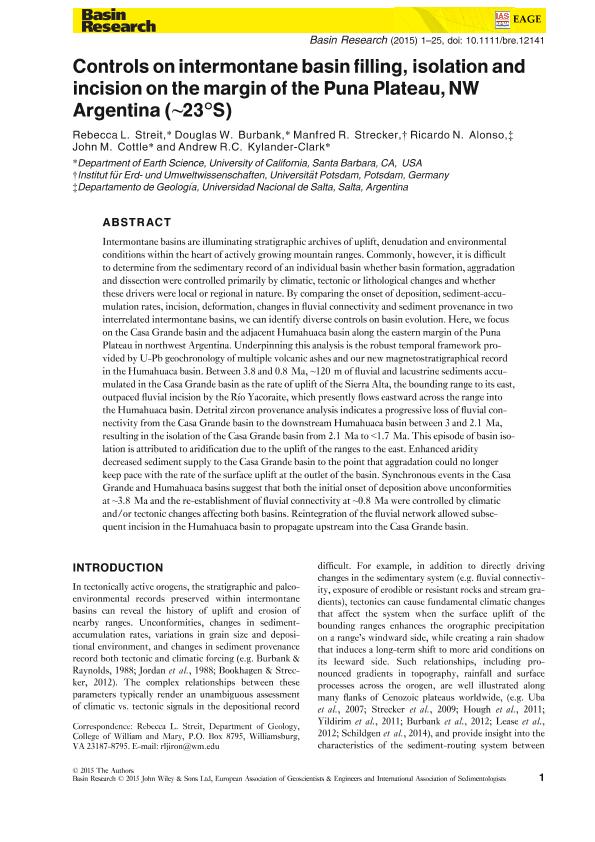Artículo
Controls on intermontane basin filling, isolation and incision on the margin of the Puna Plateau, NW Argentina (~23°S)
Streit, Rebecca L.; Burbank, Douglas W.; Strecker, Manfred R.; Alonso, Ricardo Narciso ; Cottle, John M.; Kylander Clark, Andrew R.C.
; Cottle, John M.; Kylander Clark, Andrew R.C.
 ; Cottle, John M.; Kylander Clark, Andrew R.C.
; Cottle, John M.; Kylander Clark, Andrew R.C.
Fecha de publicación:
02/2017
Editorial:
Wiley Blackwell Publishing, Inc
Revista:
Basin Research
ISSN:
0950-091X
Idioma:
Inglés
Tipo de recurso:
Artículo publicado
Clasificación temática:
Resumen
Intermontane basins are illuminating stratigraphic archives of uplift, denudation and environmental conditions within the heart of actively growing mountain ranges. Commonly, however, it is difficult to determine from the sedimentary record of an individual basin whether basin formation, aggradation and dissection were controlled primarily by climatic, tectonic or lithological changes and whether these drivers were local or regional in nature. By comparing the onset of deposition, sediment-accumulation rates, incision, deformation, changes in fluvial connectivity and sediment provenance in two interrelated intermontane basins, we can identify diverse controls on basin evolution. Here, we focus on the Casa Grande basin and the adjacent Humahuaca basin along the eastern margin of the Puna Plateau in northwest Argentina. Underpinning this analysis is the robust temporal framework provided by U-Pb geochronology of multiple volcanic ashes and our new magnetostratigraphical record in the Humahuaca basin. Between 3.8 and 0.8 Ma, ~120 m of fluvial and lacustrine sediments accumulated in the Casa Grande basin as the rate of uplift of the Sierra Alta, the bounding range to its east, outpaced fluvial incision by the Río Yacoraite, which presently flows eastward across the range into the Humahuaca basin. Detrital zircon provenance analysis indicates a progressive loss of fluvial connectivity from the Casa Grande basin to the downstream Humahuaca basin between 3 and 2.1 Ma, resulting in the isolation of the Casa Grande basin from 2.1 Ma to <1.7 Ma. This episode of basin isolation is attributed to aridification due to the uplift of the ranges to the east. Enhanced aridity decreased sediment supply to the Casa Grande basin to the point that aggradation could no longer keep pace with the rate of the surface uplift at the outlet of the basin. Synchronous events in the Casa Grande and Humahuaca basins suggest that both the initial onset of deposition above unconformities at ~3.8 Ma and the re-establishment of fluvial connectivity at ~0.8 Ma were controlled by climatic and/or tectonic changes affecting both basins. Reintegration of the fluvial network allowed subsequent incision in the Humahuaca basin to propagate upstream into the Casa Grande basin.
Palabras clave:
Intermontane
,
Basin
,
Puna
,
Argentina
Archivos asociados
Licencia
Identificadores
Colecciones
Articulos(CCT - NOA SUR)
Articulos de CTRO.CIENTIFICO TECNOL.CONICET - NOA SUR
Articulos de CTRO.CIENTIFICO TECNOL.CONICET - NOA SUR
Articulos(INSUGEO)
Articulos de INST.SUP.DE CORRELACION GEOLOGICA
Articulos de INST.SUP.DE CORRELACION GEOLOGICA
Citación
Streit, Rebecca L.; Burbank, Douglas W.; Strecker, Manfred R.; Alonso, Ricardo Narciso; Cottle, John M.; et al.; Controls on intermontane basin filling, isolation and incision on the margin of the Puna Plateau, NW Argentina (~23°S); Wiley Blackwell Publishing, Inc; Basin Research; 29; 2-2017; 131-155
Compartir
Altmétricas



